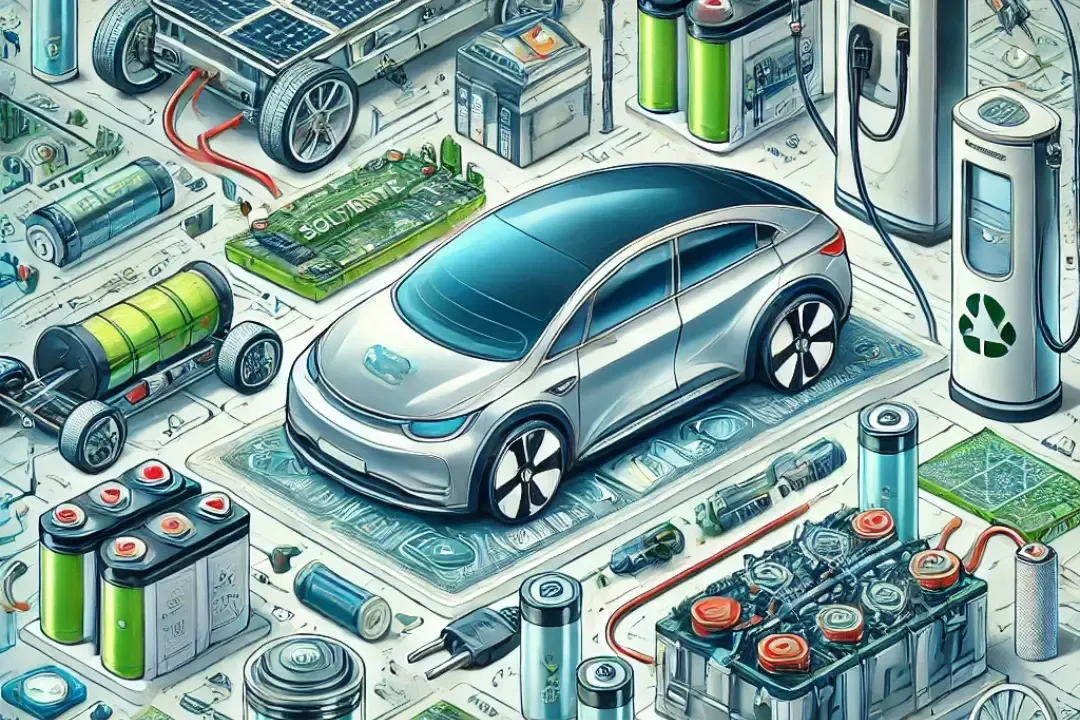Future Trends in EV Battery Technology:Innovations and Insights Ahead-ElectriVerse
 |
Current State of EV Batteries |
Lithium-ion batteries dominate the electric vehicle (EV) market due to their well-balanced energy density, cost, and safety features. These batteries have become the cornerstone of modern EVs, enabling significant progress in the adoption of electric mobility. However, they are not without limitations. Short life cycles, potential overheating issues, and the high costs of raw materials such as lithium and cobalt remain challenges that manufacturers and researchers are striving to overcome.
Major players like Tesla, Volkswagen, and Toyota are leading the charge in developing next-generation battery technologies. For instance, Tesla’s advancements in battery chemistry and manufacturing processes aim to increase battery efficiency while reducing production costs. Similarly, Toyota is heavily invested in solid-state battery research, which could redefine the industry’s approach to energy storage. Innovations like lithium-silicon anodes and advanced thermal management systems are also gaining traction, promising improved performance, longevity, and safety.
Emerging Battery Technologies
The future of EV batteries lies in groundbreaking technologies that address the limitations of current lithium-ion systems. Solid-state batteries represent a pivotal innovation. These batteries replace the liquid electrolyte found in conventional lithium-ion batteries with a solid alternative, eliminating the risks of leaks and fires while enhancing energy density and durability. Early prototypes suggest that solid-state batteries could achieve energy densities exceeding 500 Wh/kg, more than double the 200 Wh/kg typically offered by traditional lithium-ion batteries. This improvement would significantly extend the range of electric vehicles and reduce charging times.
In addition to solid-state batteries, other emerging technologies are making strides. Sodium-ion batteries, for example, offer a more abundant and cost-effective alternative to lithium-based systems. Although their energy density is currently lower, ongoing research is closing the gap. Lithium-sulfur batteries also hold promise due to their high theoretical energy density and lower cost, while zinc-air batteries offer advantages in energy storage capacity and sustainability. These advancements signal a transformative period for the battery industry, with multiple pathways toward better performance, affordability, and environmental impact.
Sustainable and Recyclable Batteries
As the EV industry grows, the focus on sustainability and recyclability becomes increasingly critical. The environmental impact of battery production, particularly the extraction and processing of raw materials, has prompted the industry to explore circular economy solutions. Recycling used lithium-ion batteries not only reduces waste but also addresses supply chain challenges by recovering valuable materials like lithium, cobalt, and nickel.
Regulatory frameworks in regions like the European Union are pushing for stricter battery collection and recycling standards. Technologies enabling closed-loop recycling systems are gaining momentum, allowing materials to be reused in new battery production. Companies such as Redwood Materials and Umicore are pioneering advanced recycling processes that maximize material recovery rates and minimize environmental harm.
Moreover, manufacturers are integrating recycled materials into their production lines. For example, using recycled cobalt and nickel in new batteries not only reduces dependency on mining but also lowers production costs. The industry’s shift towards sustainable practices is essential for mitigating the ecological footprint of EV batteries and ensuring a more responsible approach to growth.
Charging and Energy Storage Innovations
Rapid advancements in battery technology are revolutionizing the EV charging experience. The development of solid-state batteries and other emerging technologies is paving the way for ultra-fast charging systems capable of replenishing a battery within minutes. This innovation addresses one of the most significant barriers to EV adoption—charging convenience.
Beyond faster charging, new approaches to energy storage are emerging. Battery swapping, for instance, allows EV owners to exchange depleted batteries for fully charged ones at specialized stations, drastically reducing downtime. Wireless charging technologies are also under development, offering the potential for seamless energy transfer without the need for physical connectors. These systems could transform public charging infrastructure, making it more accessible and user-friendly.
Energy storage innovations are not limited to vehicles. Stationary energy storage systems that leverage EV battery technology are increasingly being used for grid stabilization and renewable energy integration. These systems play a crucial role in balancing supply and demand, ensuring the efficient use of clean energy sources like wind and solar power. Investments in research and development are accelerating these advancements, creating a more integrated and sustainable energy ecosystem.
Market Dynamics and Adoption
The economic landscape of battery manufacturing is undergoing rapid transformation. The steady decline in lithium-ion battery prices—driven by technological improvements and economies of scale—is making EVs more affordable for a broader audience. According to industry projections, the cost of EV batteries could drop below $100 per kWh by 2030, a tipping point that would make electric vehicles cost-competitive with internal combustion engine cars.
Government policies aimed at reducing carbon emissions are also accelerating EV adoption. Subsidies, tax incentives, and investments in charging infrastructure are creating favorable conditions for both consumers and manufacturers. For example, countries like Norway and China have implemented aggressive policies to phase out fossil fuel vehicles, further boosting EV demand.
The global battery market is poised for exponential growth, with forecasts suggesting it could quadruple by 2030. This surge will be driven by increased demand for electric vehicles, coupled with advancements in battery technologies and production capabilities. As competition intensifies, manufacturers are focusing on differentiation through innovation, sustainability, and cost reduction, ensuring a dynamic and rapidly evolving market.
Conclusion
The evolution of EV battery technologies is at the heart of the transition to a more sustainable and electrified future. From the dominance of lithium-ion systems to the promise of solid-state and other emerging technologies, the industry is witnessing unprecedented innovation. Coupled with advancements in recycling, charging, and energy storage, these developments are shaping a more accessible and environmentally friendly EV ecosystem. As market dynamics continue to shift and adoption rates climb, the future of electric mobility looks brighter than ever.





